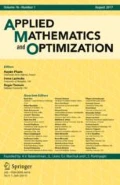Abstract
In this paper we study the null controllability property for a single population model in which the population y depends on time t, space x, age a and size \(\tau \). Moreover, the diffusion coefficient k is degenerate at a point of the domain or both extremal points. Our technique is essentially based on Carleman estimates. The \(\tau \) dependence requires us to modify the weight for the Carleman estimates, and accordingly the proof of the observability inequality. Thanks to this observability inequality we obtain a null controllability result for an intermediate problem and finally for the initial system through suitable cut off functions.
Similar content being viewed by others
References
Ainseba, B.: Exact and approximate controllability of the age and space population dynamics structured model. J. Math. Anal. Appl. 275, 562–574 (2002)
Ainseba, B., Echarroudi, Y., Maniar, L.: Null controllability of population dynamics with degenerate diffusion. Differ. Integr. Equ. 26, 1397–1410 (2013)
Alabau-Boussouira, F., Cannarsa, P., Fragnelli, G.: Carleman estimates for degenerate parabolic operators with applications to null controllability. J. Evol. Equ. 6, 161–204 (2006)
Aniţa, S.: Analysis and Control of Age-Dependent Population Dynamics. Springer, Netherlands, Heidelberg (2000)
Barbu, V., Iannelli, M., Martcheva, M.: On the controllability of the Lotka–McKendrick model of population dynamics. J. Math. Anal. Appl. 253, 142–165 (2001)
Boutaayamou, I., Echarroudi, Y.: Null controllability of population dynamics with interior degeneracy. Electron. J. Differ. Equ. 2017, 1–21 (2017)
Boutaayamou, I., Fragnelli, G.: A degenerate population system: Carleman estimates and controllability. Nonlinear Anal. 195, 111742 (2020)
Cannarsa, P., Fragnelli, G., Rocchetti, D.: Controllability results for a class of one-dimensional degenerate parabolic problems in nondivergence form. J. Evol. Equ. 8, 583–616 (2008)
Cannarsa, P., Fragnelli, G., Rocchetti, D.: Null controllability of degenerate parabolic operators with drift. Netw. Heterog. Media 2, 693–713 (2007)
Echarroudi, Y., Maniar, L.: Null controllability of a model in population dynamics. Electron. J. Differ. Equ. 2014, 1–20 (2014)
Favini, A., Yagi, A.: Degenerate Differential Equations in Banach Spaces, Pure and Applied Mathematics: A Series of Monographs and Textbooks, 215. M. Dekker, New York (1998)
Feller, W.: The parabolic differential equations and the associated semigroups of transformations. Ann. Math. 55, 468–519 (1952)
Fernández-Cara, E., Guerrero, S.: Global Carleman inequalities for parabolic systems and applications to controllability. SIAM J. Control Optim. 45, 1395–1446 (2006)
Fragnelli, G.: Controllability for a population equation with interior degeneracy. Pure Appl. Funct. Anal. 4, 803–824 (2019)
Fragnelli, G.: Null controllability for a degenerate population model in divergence form via Carleman estimates. Adv. Nonlinear Anal. (2020). https://doi.org/10.1515/anona-2020-00334
Fragnelli, G.: Carleman estimates and null controllability for a degenerate population model. J. Math. Pures Appl. 115, 74–126 (2018)
Fragnelli, G., Mugnai, D.: Carleman estimates and observability inequalities for parabolic equations with interior degeneracy. Adv. Nonlinear Anal. 2, 339–378 (2013)
Fragnelli, G., Mugnai, D.: Carleman estimates, observability inequalities and null controllability for interior degenerate non smooth parabolic equations. Mem. Am. Math. Soc. 242, v+84 (2016)
Fragnelli, G., Mugnai, D.: Carleman estimates for singular parabolic equations with interior degeneracy and non smooth coefficients. Adv. Nonlinear Anal. 6, 61–84 (2017)
Fragnelli, G., Mugnai, D.: Controllability of strongly degenerate parabolic problems with strongly singular potentials. Electron. J. Qual. Theory Differ. Equ. 50, 1–11 (2018)
Fragnelli, G., Mugnai, D.: Controllability of degenerate and singular parabolic problems: the double strong case with Neumann boundary conditions. Opuscula Math. 39, 207–225 (2019)
He, Y., Ainseba, B.: Exact null controllability of the Lobesia botrana model with diffusion. J. Math. Anal. Appl. 409, 530–543 (2014)
Maity, D., Tucsnak, M., Zuazua, E.: Controllability and positivity constraints in population dynamics with age structuring and diffusion. J. Math. Pure Appl. 129, 153–179 (2019)
Metafune, G., Pallara, D.: Trace formulas for some singular differential operators and applications. Math. Nachr. 211, 127–157 (2000)
Pugliese, A., Tonetto, L.: Well-posedness of an infinite system of partial differential equations modelling parasitic infection in an age-structured host. J. Math. Anal. Appl. 284, 144–164 (2003)
Uesaka, M., Yamamoto, M.: Carleman estimate and unique continuation for a structured population model. Appl. Anal. 95, 599–614 (2015)
Webb, G.F.: Population models structured by age, size, and spatial position. Structured Population Models in Biology and Epidemiology. Lecture Notes in Math, 1936, pp. 1–49. Springer, Berlin (2008)
Author information
Authors and Affiliations
Corresponding author
Additional information
Publisher's Note
Springer Nature remains neutral with regard to jurisdictional claims in published maps and institutional affiliations.
The first author is a member of the Gruppo Nazionale per l’Analisi Matematica, la Probabilità e le loro Applicazioni (GNAMPA) of the Istituto Nazionale di Alta Matematica (INdAM) and she is supported by the FFABR Fondo per il finanziamento delle attività base di ricerca 2017, by the INdAM- GNAMPA Project 2019 Controllabilità di PDE in modelli fisici e in scienze della vita, by Fondi di Ateneo 2015/16 of the University of Bari Problemi differenziali non linearii and by PRIN 2017-2019 Qualitative and quantitative aspects of nonlinear PDEs.
The second author is supported by Grant-in-Aid for Scientific Research (S) 15H05740 of Japan Society for the Promotion of Science and by The National Natural Science Foundation of China (No. 11771270, 91730303), and prepared with the support of the “RUDN University Program 5-100”
Appendix
Appendix
1.1 Proof of Proposition 4.2
Let us consider a smooth function \(\xi : [0,1] \rightarrow \mathbb R\) such that
Then, integrating by parts one has
Hence, using Young’s inequality
It follows that,
Thus,
Rights and permissions
About this article
Cite this article
Fragnelli, G., Yamamoto, M. Carleman Estimates and Controllability for a Degenerate Structured Population Model. Appl Math Optim 84, 999–1044 (2021). https://doi.org/10.1007/s00245-020-09669-0
Published:
Issue Date:
DOI: https://doi.org/10.1007/s00245-020-09669-0
Keywords
- Structured population model
- Degenerate equations
- Carleman estimates
- Null controllability
- Observability inequality



